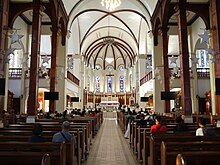Baguio Cathedral
| Baguio Cathedral | |
|---|---|
| Our Lady of Atonement Cathedral | |
Catedral de Nuestra Señora de la Expiación ( Marlo Mendoza Peralta | |
| Bishop(s) | Sede vacante[1] |
| Rector | Berlynden B. Dao-anis[2] |
| Assistant priest(s) | Marion Joseph S. Nebres |
The Our Lady of the Atonement Cathedral, commonly known as Baguio Cathedral, is a
Dedicated to the
History
In 1907, a Catholic mission chapel, dedicated to
During the Second World War, the cathedral was an evacuation center, and it withstood the
In February 1986, anti-dictatorship organizers based in the Azotea Building and in Cafe Amapola on Session Road learned that the People Power Revolution had begun in Manila. Deciding that their locations were too unsafe, they encamped in the courtyard of the cathedral, which was located on higher ground.[6] Thus, it became the site where Baguio residents had gathered to protest the abuses of the Marcos administration—their own contribution to the largely peaceful revolution.[7]
Features

The cathedral has a distinctive façade with a rose window and twin square belfries with pyramidal roofs.[5] Within its large courtyard is a viewing deck that overlooks Session Road and the downtown commercial district of Baguio.
The cathedral is accessible to pedestrians from Session Road via 104-step stone staircase that ends at a
A mural on the cathedral grounds, carved by Baguio artist Clinton Pagao Aniversario in 2017,[9] honors the missionaries of the Congregatio Immaculati Cordis Mariae (CICM) who first began Roman Catholic evangelical work in Mountain Province in the 1900s, and were eventually instrumental in the building of the cathedral.[9]
Gallery
-
Cathedral altar
-
The cathedral at night
-
The cathedral from the stairs with the largeCalvaryat the terminus of the stone stairs
References
- ^ "Bishop Bendico bids Baguio farewell". CBCP News. April 28, 2023. Retrieved April 29, 2023.
- ^ "Diocese of Baguio". Catholink. Retrieved April 29, 2023.
- ^ "Baguio Catholic Cathedral". Landmarks and Scenic Sites: The City of Baguio. Archived from the original on April 11, 2008. Retrieved April 19, 2008.
- ^ Cabreza, Vincent (July 11, 2011). "Baguio cathedral celebrates 75 years". Inquirer Northern Luzon.
- ^ a b Layug, p. 76
- ^ "EDSA '86 up north: The day Baguio turned yellow".
- ^ "Remembering the People's Power Revolution in Baguio - HERALD EXPRESS | News in Cordillera and Northern Luzon". February 23, 2019.
- ^ Layug, p. 77
- ^ a b Opiña, Rimaliza A. (January 15, 2017). "Mural immortalizes CICM missionaries". Baguio Midland Courrier. Archived from the original on September 25, 2021. Retrieved September 25, 2021.
External links
 Media related to Baguio Cathedral at Wikimedia Commons
Media related to Baguio Cathedral at Wikimedia Commons- Baguio Cathedral on Facebook
References
- Layug, Benjamin Locsin (2007). A Tourist Guide to Notable Philippine Churches. Pasig, Philippines: New Day Publishers. pp. 76–77. ISBN 978-971-8521-10-6.




